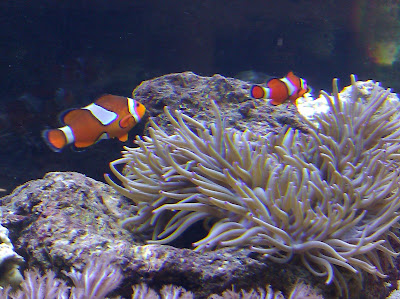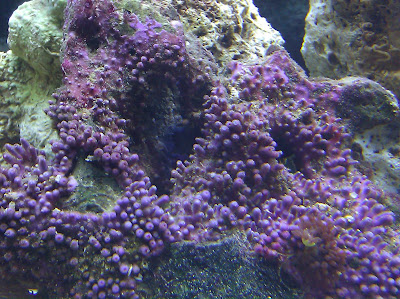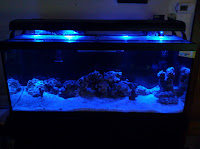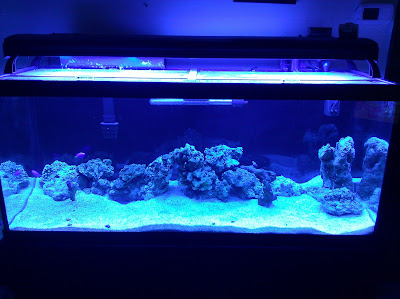By the time I'd gotten home from a short day of work the daylights had already had their 4 hour cycle. The anemone still looks nice and full, even if a little "pale". I bumped up the light timer one notch, which is 20 minutes or so (I think there are three notches per hour, but it's hard to tell). I'm going to keep bumping it one notch a day until the anemone begins to shrink - a sign that it's getting too much light. Then perhaps we'll start the additional hour per week for light acclimation.
I had enough things to do on my "need to get" list that I dropped by my LFS. The atmosphere was a nice one today, I must say. The owner was not around, but his wife was. We swapped a few stories - she said she walked in today to what she thought was a shrimp birth... Hundreds of these things swimming around. It was neat to hear how excited she still gets with saltwater discoveries like that. It gives me hope this hobby won't get old, at least for my wife and me.
I grabbed a phosphate test kit from the get-go, and the browsed while she helped the customer before me. I spotted the Peppermint Shrimp and eyed them quickly before searching for their price. Ten dollars each, or three for $24. Phosphate kit was also ten bucks. So far so good... can't spend too much. I told her about the tribulations with the anemone. She conveyed a couple anecdotes about her experiences with anemones. The moral of her story was that if it were going to die, it would be obvious. Good news there.
While I was there, I inquired about the Cardinals. They've only snacked a bit here and there for the last week. I asked what they use to feed theirs - she said "Krill". I have Krill pellets... "No, I mean Krill". Show me this Krill. She produced a can of freeze dried krill. I quickly scanned the ingredients - krill and a vitamin supplement. She demonstrated how to feed krill on their clown/anemone tank. To my surprise, she placed the last bit of krill right into the anemone. It closed up on her fingers and she pulled her hand out. Wow, I haven't yet gotten the nerve to do that.
I told her if the Cardinals keep snacking this week, I'll be in for some.
I explained my concerns for the anemone being bleached and told her I've read they can be nursed back as long as they are target fed everyday - I've heard of using Mysis Shrimp for this. She agreed that they love it and produced a frozen package of it.
Out the door for $28 and change and had one of the most reassuring and informative visits I've had in a little while.
Once I got home my wife was excited to hear the story about the owners wife hand-feeding their anemone. She wanted to try it. She did so successfully. She even played a bit with the tentacles. I asked if they were sticky or slimy. They're sticky - good! The Clowns had some of the shrimp, but not much. The Cardinals weren't interested in it at all.
The Peppermint Shrimp, once in the tank, headed to the opposite end of the tank as the aiptasia, so no aiptasia will be consumed today. And the small cloudy white snail we saw a week or to ago... Found it on the glass today. The shell is beginning to become pronounced. From the looks of it, it could be a Chiton, Limpet, or Stomatella. As it matures, I'm sure it will become obvious.
Here are some photo's from this afternoon:
 |
| The Brittle Starfish made a small appearance this afternoon. |
 |
| Here is the side view of the "Snail" we saw a couple weeks ago. |
 |
| Here is the underside of the unknown "Snail". |
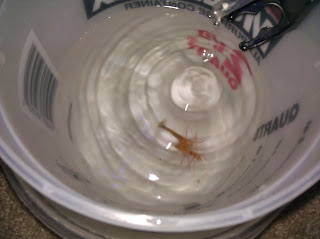 |
| Wasn't thinking too well. It's the only picture so far of the Peppermint Shrimp. |





























